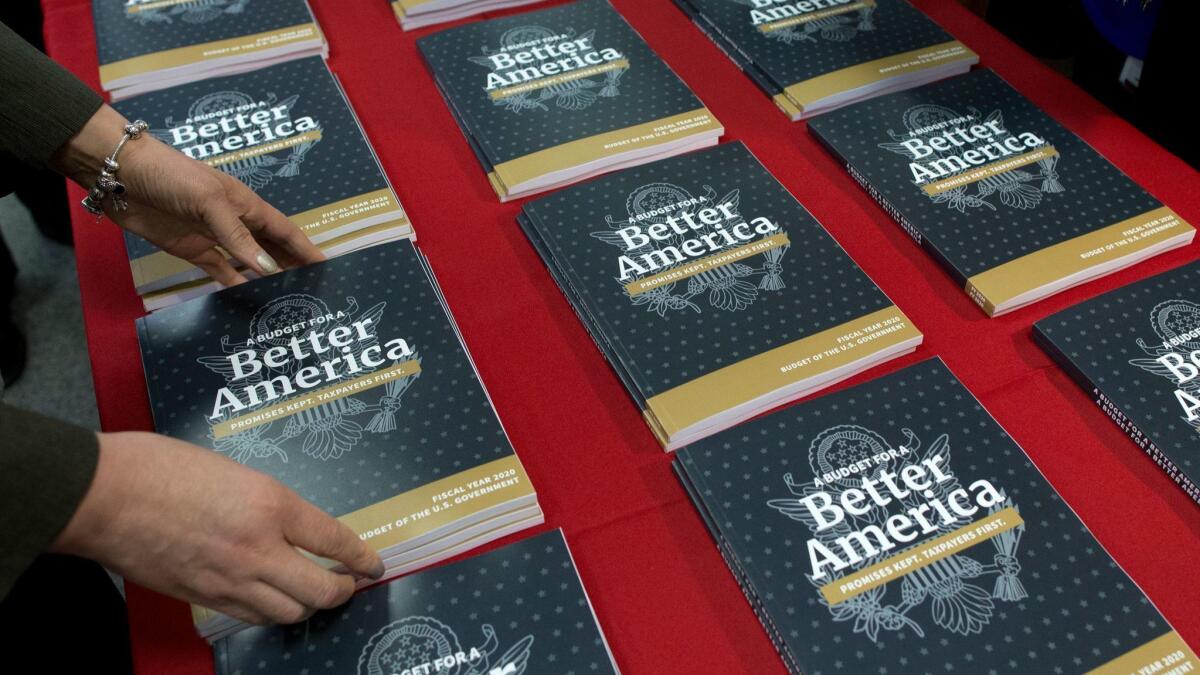Editorial: Trump’s budget priorities are, unsurprisingly, disheartening

The endless press coverage notwithstanding, the details of President Trump’s new $4.7 trillion budget proposal — the cuts here, the increases there — aren’t all that important in the long run. Congress typically ignores most, if not all, of the headline-grabbing initiatives presidents pack into their annual spending blueprints. And with Democrats now controlling the House, Trump’s plan is even more likely to get the doorstop treatment.
Still, the budget is a major statement about presidential priorities, and Trump’s are disheartening. In both the overall thrust and many of the smaller details, the budget betrays the president’s desire to put one interest — national security — ahead of all others, and to shift wealth from the lowest-income Americans back to the more affluent.
At a budget briefing Monday, a spokesman for the Trump administration suggested that the administration’s top priority was reining in the federal deficit, which is expected to top $1 trillion in the fiscal year that ends Sept. 30. He then said the problem was not the fault of Trump’s policies.
Wait, what?
Trump’s tax and spending policies are an enormous factor in the budget deficit. Yes, the tax cut and the big boost in military spending have stimulated the economy, resulting in a small increase in federal tax revenues. But economists agree that revenues would be substantially higher had the tax cut not gone into effect. That’s why the tax cut is expected to add $1.5 trillion to the federal debt over its first 10 years, according Congressional Budget Office estimates.
Trump’s budget calls for an additional $8.6 billion for his border wall, teeing up another potential showdown with Congress.
Making matters worse, the budget proposes to make permanent the lower tax rates for individuals and for capital gains, which are due to expire in 2025 and 2026. That move would cost an addition $1 trillion over four years.
If Trump were serious about narrowing the federal deficit, he would seek to cut spending broadly while raising revenues. Instead, he’s looking to lavish more money on the military while cutting aid to lower-income Americans. Overall, the budget for defense would rise 5%, while non-defense domestic spending would be lowered by 9% in fiscal 2020. Over 10 years, safety-net programs would be cut by $1.9 trillion.
The defense proposal is galling. The administration says it will honor the tight spending caps Congress imposed in a 2011 budget deal on both defense and discretionary spending. But it’s also proposing to funnel the Pentagon an additional $165 billion through the uncapped “overseas contingency operations” account created to fund the war efforts in Iraq and Afghanistan, plus $9 billion for “emergency requirements.” That’s too clever by half.
To partially offset the tax cuts and military spending increases, the budget proposes to take a chainsaw to a number of federal benefit programs, including food stamps, state welfare block grants, disability benefits and the earned income tax credit. On Medicaid and several other healthcare-related programs, the administration seeks to save money not by bringing down the cost of care, but by making it available to fewer people. All these cuts would disproportionately affect poor people.
Spending cuts need to be part of the solution to Washington’s fiscal mess. And some of the programs targeted by Trump may not be producing the results they promised. But concentrating the pain on the lowest-income Americans is just cruel.
Granted, not every domestic program was cut. For example, in the Interior Department the administration is proposing to boost spending on leasing programs for logging, drilling and mining on federal lands even as it slashes funding for national parks.
Enter the Fray: First takes on the news of the minute »
And the administration did make a nod to some programs supported by Democrats, such as the $1 billion in grants it would provide over several years for “supporting underserved populations and stimulating employer investments in child care for working families.” Still, that’s a pittance compared to the need.
Meanwhile, Trump’s budget calls for an additional $8.6 billion for his border wall, teeing up another potential showdown with Congress. Less than a month ago, Trump declared a national emergency to justify shifting billions of additional dollars into the project after Congress provided only $1.375 billion. The Senate is poised to give final approval soon to a resolution rejecting the emergency declaration and canceling much of the extra wall spending, but Trump is expected to veto it and count on congressional Republicans to sustain him.
Ordinarily, Trump’s new request for wall funding would be seen as the first step in the usual give-and-take between the White House and Congress. This year, however, it’s freighted with the threat that Trump will simply write himself a check for whatever amount he wants to spend. That’s another reason for congressional Republicans to join Democrats in terminating Trump’s bogus emergency, making it clear to the president that they’re not about to give up Congress’ constitutional power over the purse.
Follow the Opinion section on Twitter @latimesopinionand Facebook
More to Read
A cure for the common opinion
Get thought-provoking perspectives with our weekly newsletter.
You may occasionally receive promotional content from the Los Angeles Times.






